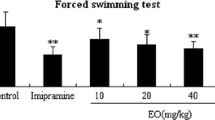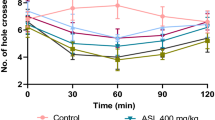Abstract
Species of genus Ocimum (Lamiaceae) are economically important due to their essential oils and utilization as medicine for many disorders, including the central nervous system. A previous study showed seasonal variations in chemical profile and in central nervous system activities of essential oil from Ocimum gratissimum L. The preparation obtained in spring was able to protect the animals against tonic episodes induced by electroshock while those obtained in other seasons were effective in increasing barbiturate-induced sleeping time. The chemical analysis of essential oils showed eugenol and 1,8-cineole as principal compounds and trans-caryophyllene as a sesquiterpene in higher proportion. In the present study these three compounds were evaluated, separately or mixed in the same proportion detected in spring, in the open-field and rota-rod tests, against convulsions induced by pentylenetetrazole (PTZ; 60 mg/kg, subcutaneously, s.c.) or maximal electroshock (MES; 50 mA, 0.11 s) and in sodium pentobarbital (45 mg/kg, intraperitoneally, i.p.)-induced sleeping time. The compounds, isolated or in association, did not show efficaciousness in altering convulsive episodes, and only when in association were able to increase sleeping time duration. The absence of similar essential oil activity in the isolated compounds contributes to the idea that the major compounds are not always responsible for a biological effect observed in medicinal plant preparations. This view reinforces the concept of a multitargeted approach as a therapeutic strategy, contributing to an integrated understanding of the phenomena related to experimental activity of a complex herbal mixture.

Similar content being viewed by others
References
Rates SMK (2001) Plants as source of drugs. Toxicon 39:603–613
Ulrich-Merzenich G, Zeitler H, Jobst D, Panek D, Vetter H, Wagner H (2007) Application of the “-omic” technologies in phytomedicine. Phytomedicine 14:70–82
Newman DJ, Cragg GM, Snader KM (2003) Natural products as sources of new drugs over the period 1981–2002. J Nat Prod 66:1022–1037
Phillipson JD (2001) Phytochemistry and medicinal plants. Phytochemistry 56:237–243
Carlini EA (2003) Plants and the central nervous system. Pharmacol Biochem Behav 75:501–512
De Smet PAGM (1997) The role of plant-derived drugs and herbal medicines in healthcare. Drugs 54:801–840
Duke JA (1985) CRC handbook of medicinal herbs. Boca Raton, CRC, p 677
Tortoriello J, Romero O (1992) Plants used by Mexican traditional medicine with presumable sedative properties: an ethnobotanical approach. Arch Med Res 23:111–116
De Feo V, Senatore F (1993) Medicinal plants and phytotherapy in the Amalfitan Coast, Salerno Province, Campania, Southern Italy. J Ethnopharmacol 39:39–51
Pérez de Alejo JL, Miranda R, Rodriguez G (1996) Actividad antidepresiva y anticonvulsivante del extracto fluido del Ocimum tenuiflorum L. (albahaca morada). Rev Cuba Plantas Med 1:8–12
Vázquez FM, Suarez MA, Pérez A (1997) Medicinal plants used in the Barros Area, Badajoz Province (Spain). J Ethnopharmacol 55:81–85
Di Stasi LC, Oliveira GP, Carvalhaes MA, Queiroz M Jr, Tien OS, Kakinami SH, Reis MS (2002) Medicinal plants popularly used in the Brazilian Tropical Atlantic Forest. Fitoterapia 73:69–91
Freire CMM, Marques MOM, Costa M (2006) Effects of seasonal variation on the central nervous system activity of Ocimum gratissimum L. essential oil. J Ethnopharmacol 105:161–166
Dandiya PC, Cullumbine H (1959) Studies on Acorus calamus: some pharmacological actions of the volatile oil. J Pharmacol Exp Ther 125:353–359
Walsh RN, Cummins RA (1976) The open-field test: a critical review. Psychol Bull 83:482–504
Dunham NW, Miya TS (1957) A note on a simple apparatus for detecting neurological deficits in rats and mice. J Am Pharm Assoc 46:208–209
Dr Duke’s Phytochemical and Ethnobotanical Databases. USDA-ARS-NGRI, Beltsville Agricultural Research Centre, Maryland. http://www.ars-grin.gov/duke/. Accessed 29 Jan 2009
Dallmeier K, Carlini EA (1981) Anesthetic, hypothermic, myorelaxant and anticonvulsant effects of synthetic eugenol derivatives and natural analogues. Pharmacology 22:113–127
Guenette SA, Beaudry F, Marier JF, Vachon P (2006) Pharmacokinetics and anesthetic activity of eugenol in male Sprague-Dawley rats. J Vet Pharmacol Ther 29:265–270
Guenette SA, Hélie P, Beaudry F, Vachon P (2007) Eugenol for anesthesia of African clawed frogs (Xenopus laevis). Vet Anaesth Analg 34:164–170
Müller M, Pape HC, Speckmann EJ, Gorji A (2006) Effect of eugenol on spreading depression and epileptiform discharges in rat neocortical and hippocampal tissues. Neuroscience 140:743–751
Santos FA, Rao VS (2000) Antiinflammatory and antinociceptive effects of 1,8-cineole a terpenoid oxide present in many plant essential oils. Phytother Res 14:240–244
Umezu T, Sakata A, Ito H (2001) Ambulation-promoting effect of peppermint oil and identification of its active constituents. Pharmacol Biochem Behav 69:383–390
Devi KP, Sreepriya M, Devaki T, Balakrishna K (2003) Antinociceptive and hypnotic effects of Premna tomentosa L. (Verbenaceae) in experimental animals. Pharmacol Biochem Behav 75:261–264
Löscher W, Schmidt D (1988) Which animal models should be used in the search for new antiepileptic drugs? A proposal based on experimental and clinical considerations. Epilepsy Res 2:145–181
Williamson EM (2001) Synergy and other interactions in phytomedicines. Phytomedicine 8:401–409
Spinella M (2002) The importance of pharmacological synergy in psychoactive herbal medicines. Altern Med Rev 7:130–137
Capasso A, Sorrentino L (2005) Pharmacological studies on the sedative and hypnotic effect of Kava kava and Passiflora extracts combination. Phytomedicine 12:39–45
Pieters L, Vlietinck AJ (2005) Bioguided isolation of pharmacologically active plant components, still a valuable strategy for the finding of new lead compounds? J Ethnopharmacol 100:57–60
Verpoorte R, Choi YH, Kim HK (2005) Ethnopharmacology and systems biology: a perfect holistic match. J Ethnopharmacol 100:53–56
Wagner H, Ulrich-Merzenich G (2009) Synergy research: approaching a new generation of phytopharmaceuticals. Phytomedicine 16:97–110
Acknowledgments
L. A. Galindo and A. M. Pultrini received MS scholarships from CAPES (Coordenação de Aperfeiçoamento de Pessoal de Nível Superior).
Author information
Authors and Affiliations
Corresponding author
Rights and permissions
About this article
Cite this article
Galindo, L.A., de Moraes Pultrini, A. & Costa, M. Biological effects of Ocimum gratissimum L. are due to synergic action among multiple compounds present in essential oil. J Nat Med 64, 436–441 (2010). https://doi.org/10.1007/s11418-010-0429-2
Received:
Accepted:
Published:
Issue Date:
DOI: https://doi.org/10.1007/s11418-010-0429-2




